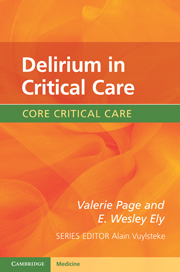Crossref Citations
This Book has been
cited by the following publications. This list is generated based on data provided by Crossref.
Egerod, Ingrid
2013.
Intensive care delirium: the new black.
Nursing in Critical Care,
Vol. 18,
Issue. 4,
p.
164.
KOGA, Yuji
MURATA, Hiroaki
and
YAMASE, Hiroaki
2014.
Validity and Reliability of the Japanese Version of Intensive Care Delirium Screening Checklist(ICDSC).
Yamaguchi Medical Journal,
Vol. 63,
Issue. 2,
p.
103.
Pasechnik, I. N.
Makhlaj, A. V.
Teplyakova, A. N.
Gubajdullin, R. R.
Sal’nikov, P. S.
Borisov, A. Yu.
and
Berezenko, M. N.
2015.
New approach to postoperative delirium treatment.
Khirurgiya. Zhurnal im. N.I. Pirogova,
p.
71.
Ramoo, Vimala
Abu, Harlinna
Rai, Vineya
Surat Singh, Surindar Kaur
Baharudin, Ayuni Asma’
Danaee, Mahmoud
and
Thinagaran, Raveena Rajalachimi R
2018.
Educational intervention on delirium assessment using confusion assessment method‐ICU (CAM‐ICU) in a general intensive care unit.
Journal of Clinical Nursing,
Vol. 27,
Issue. 21-22,
p.
4028.
Luther, Roseanne
and
McLeod, Anne
2018.
The effect of chronotherapy on delirium in critical care – a systematic review.
Nursing in Critical Care,
Vol. 23,
Issue. 6,
p.
283.
Andersson, Morgan
Fridh, Isabell
and
Lindahl, Berit
2019.
Is it possible to feel at home in a patient room in an intensive care unit? Reflections on environmental aspects in technology‐dense environments.
Nursing Inquiry,
Vol. 26,
Issue. 4,
Sofronov, A. G.
Goncharov, V. N.
and
Skvortsov, V. Y.
2020.
Dynamics of changes in water sectors in patients with alcoholic delirious syndrome.
V.M. BEKHTEREV REVIEW OF PSYCHIATRY AND MEDICAL PSYCHOLOGY,
p.
49.
Engwall, Marie
Jutengren, Göran
Bergbom, Ingegerd
Lindahl, Berit
and
Fridh, Isabell
2021.
Patients’ Self-Reported Recovery After an Environmental Intervention Aimed to Support Patient’s Circadian Rhythm in Intensive Care.
HERD: Health Environments Research & Design Journal,
Vol. 14,
Issue. 4,
p.
194.
Ramineni, Anil
and
Dangayach, Neha
2021.
Mount Sinai Expert Guides.
p.
241.





